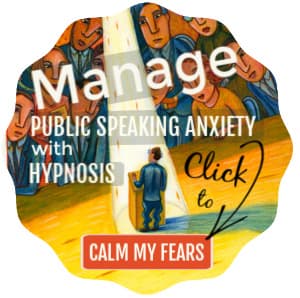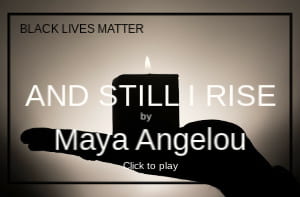- HOME ›
- Speech delivery ›
- How to use pauses effectively
Tips for using pauses in speeches
By: Susan Dugdale
How to use the power of silence in a speech
Pausing adds power, drama to your speech. Used well, your silences will literally speak LOUDER than your words.
What's on this page:
- the 5 benefits of using pauses in a speech for the speaker and for the listener
- the difference between a panic pause and a planned pause
- how to use punctuation as a guide, (the counting technique), to let you know when to pause and how long for
- 3 pieces of well-known text to practice with and tips for further practice
- 3 audio clips demonstrating the counting technique
Learning when to pause, and for how long, is a skill, and like all skills it improves with practice.
The counting technique using punctuation that I've outlined below is effective and easily mastered. I know because it's what I use myself and have taught for many years. I've seen and heard the results it delivers. In short, the method works. It's magical.
But why use pauses, particularly in public speaking?
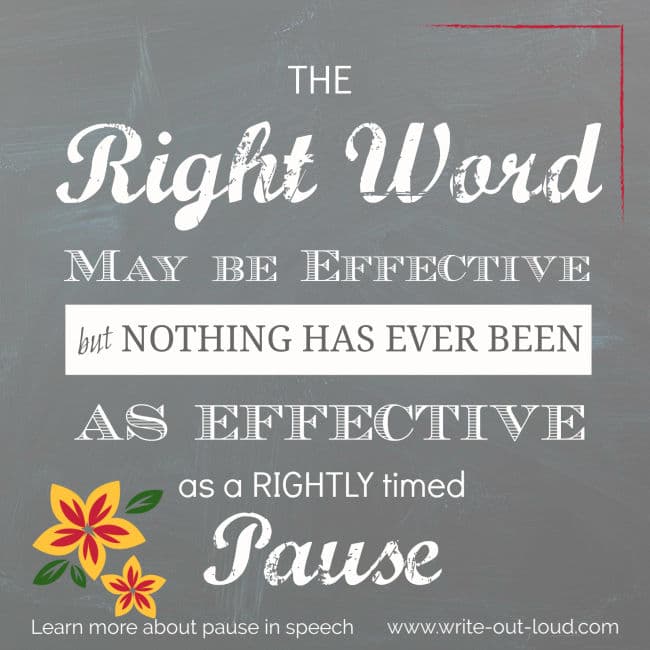
The benefits of using pauses in speeches
The benefits pausing in speech brings are many. And very generously those benefits are equally shared between the person speaking as well as the person listening. They are truly win-win.
If you're the speaker...
A pause in the right place at the right time gives YOU:
1. time to breathe properly which in turn will help settle any nervous tension you may be feeling, as well as allowing you to use your voice effectively
2. time to consider what you're going to say next. Very important!
3. time to receive, and digest the feedback you're getting from your audience.
Are they smiling? Are they leaning forward eager to hear more? Are they laughing in the right places?
4. control over the pace of your speech. You can speed it up, slow it down as you need to.
5. the means to convey emotion, emphasize or herald important information, play up a punch line, wait for laughter to settle, signal an aside, indicate how you intend the audience to interpret what you're going to say next, or have just said
If you're the listener in the audience...
A pause in the right place at the right time gives you:
1. time to breathe. They're following your lead. If you are talking rapidly without pausing for breath, they'll try to keep up in order to make sense of what you're saying. Slow down. Give them time. They'll tire and you'll lose them if you don't.
2. time to think about the images or ideas you've given them. If you pile one idea on top of another too quickly it will rapidly become more difficult to grasp and follow what you're saying.
3. time to summarize what's been said. This is particularly important for complex ideas or sequential processes. The listener needs to be able to retain the correct flow of information in their minds in order to understand it.
4. time to prepare for what maybe coming next. Here's an example. The speaker is about to deliver some very bad news to his listeners. This is what he says:
"Brace yourselves. The news is not good. This morning we have found out ..."
Pausing between the two first sentences gives his listeners an indication, a warning, of what is to come. The spaces, the pauses, give them a moment or two to prepare themselves.
5. indications of your intent - how you want them to interpret your message. Do you use the pause to smile, roll your eyes, or lift your arms in mock despair? Any of those gestures guide your audience as to how you want them to take what you've said.
Good pauses and bad pauses in speech
There are differing types of pauses or silence.
Let's get straight about what sort I'm meaning here.
Panic pauses
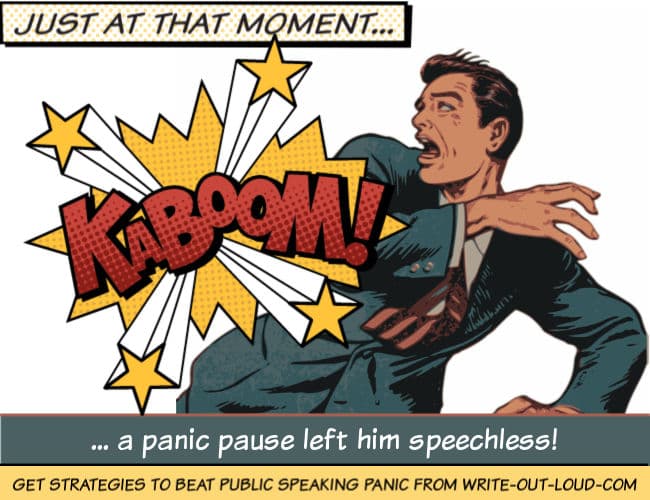
What I'm NOT talking about are the panic pauses.
These are the unplanned, "Oh, my goodness!", variety.
They arrive without invitation and like thieves, whip our words away. They leave us gulping and grasping for a way to get back to the safety of what we thought we had prepared.
And worse still, they seem to last forever.
Strategies to manage pausing through panic
Panic pauses NEED eradication. They have no place in your speech. Ever.
Click the link for proven tips and techniques to effectively manage their cause: acute anxiety.
Planned pauses in speech are good! We want them.
Planned pauses are a completely different story. They are your friend. Welcome them in, embrace and, get to know them.
Used with care, the silences of your speech will be golden. And what's more those silences add rhythm or a beat to your words. They make your speech more interesting to listen to!
Practicing pausing
Experiment with the exercises for using pauses. Listen to yourself as you go through the exercises. Record them.
You will hear a difference between conscious pausing, and pausing because you're forced to by lack of breath and running on*.
*Running on? Not pausing. Leaving no gaps between the flow of your words.
With practice, you will
'sense' the need to pause and how long to make it.
Like
my other suggestions for improving delivery skills: speaking
rate, diction,
tone, pitch and volume exercises, these tips on
using silence will add yet another dimension to your speech.
Have fun with the exercises. Please don't stress yourself by trying to master the skill in one practice. Remember habitual speech patterning IS a challenge to change. It will take regular, consistent effort to succeed.
Exercises for using pauses in speeches
Let punctuation be your guide
In printed text of any sort punctuation is used to separate words. The varying punctuation marks give us information about how we should read and comprehend them. They arrange the words in parcels, separating one unit of information from the next, so we can easily unwrap/decode them one at a time.
In short, punctuation allows us to make sequential sense of printed material.
Without punctuation we'd be looking at text similar to this.
so i said to her im going home now do you want to come with me or will you stay here ive finished all the research ive got to do on this speech
Tricky to understand at a glance, isn't it?
In speech punctuation is implied
In speech, punctuation marks are implied in the way we deliver our words. We use pauses to separate units of information to stop them from being a difficult to follow higgledy-piggledy jumble.
Excerpt from 'I have a Dream'
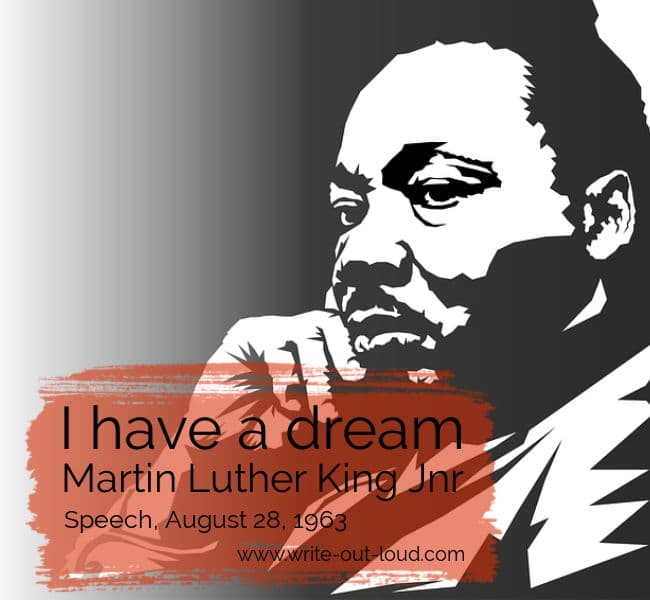
Below is an excerpt from Martin Luther King Junior's famous 1963 march on Washington for jobs and freedom speech 'I Have a Dream'.
Read it through silently several times to get the flow of ideas.
'This will be the day when all of God's children will be able to sing with a new meaning, "My country, 'tis of thee, sweet land of liberty, of thee I sing. Land where my fathers died, land of the pilgrim's pride, from every mountainside, let freedom ring."
And if America is to be a great nation, this must become true.
So let freedom ring from the prodigious hilltops of New Hampshire.
Let freedom ring from the mighty mountains of New York.
Let freedom ring from the heightening Alleghenies of Pennsylvania!
Let freedom ring from the snow capped Rockies of Colorado!
Let freedom ring from the curvaceous peaks of California!
But not only that; let freedom ring from Stone Mountain of Georgia!
Let freedom ring from Lookout Mountain of Tennessee!
Let freedom ring from every hill and every molehill of Mississippi.
From every mountainside, let freedom ring.
Try reading the extract out loud
Now read the excerpt through out loud letting the punctuation dictate where to pause and for how long.
For example, the first sentence would go something like this:
'This will be the day when all of God's children will be able to sing with a new meaning,
(Pause for breath and for emphasis. You are starting to quote something important. Give your audience time to anticipate what's coming, that is the 'new meaning'.)
"My country,
(Pause, brief-just enough to underline the importance of 'my country')
'tis of thee,
(Pause, brief- just enough to underline 'thee')
sweet land of liberty,
(Pause- brief to underline 'liberty')
of thee I sing.
(Pause for breath and to give the audience time to take in the whole meaning of the previous phrases.)
Land where my fathers died,
(Pause- brief to underline message of the phrase)
land of the pilgrim's pride,
(Pause-brief to underline message of the phrase)
from every mountainside,
(Pause-brief to underline the message of the phrase)
let freedom ring."
(Pause to allow yourself breath and the audience to take in the full impact of the previous phrases.)
(To watch a video of this speech and hear how King used pausing click the link I Have a Dream.)
The counting technique for timing pause length
In my teaching I used a counting system to help people with pausing. Often I marked their text or called it out during rehearsals.
- For a full stop or period, the count was 1,2
- For a comma, the count was 1
- For a semi-colon, the count was 1
- For a colon, the count was 1,2
- Between the end of one paragraph and the start of the next the count was 1, 2, 3
If you're a musician think of the comma, full stops/periods, colons and semi-colons as 'rests' of varying lengths.
Try the sentences from the excerpt out loud again listening for right moment to add the next phrase. Use the count method to help you.
Breathe in the silence
Use the pauses for breaths. These are the natural places to refuel. Running out of puff in the middle of a phrase or a sentence breaks the beat and its sense.
Experiment with holding the silences until you feel you have the 'beat' you want.
Have a friend listen to you trying variations and give you feedback. What you want is to sound natural.
Please note:
Rate or pace is the speed you say the words between the pauses/silences. Some phrases or sentences will naturally be faster or slower than others. The same flexibility applies to your silences. Some will be shorter than others.
Experience will teach and refine your technique. Gradually your ears will take over and let you know when to start speaking again. Until then, count!
If you are a new public speaker your judgment over the length of a pause may be totally unreliable. We're convinced we've said nothing for an age and rush to fill the vacuum.
More practice
This excerpt comes from 'David Copperfield' by Charles Dickens. It is the opening paragraphs from Chapter One - 'I am Born'.
The sentence structure is complex and requires careful thought to make it 'live' read aloud.
Begin by reading the passage through silently, noting the natural places to pause and breathe. Then read out loud using the counting method as a guide.
Carrying meaning across the pause
Remember that although you may have momentarily paused to mark a comma, the sense and forward movement of the passage must create a bridge over the gap. That means pitch, tone, volume and rate within your phrasing swings through the silence.
Unless it is a new paragraph, you are not stopping to start an entirely new idea. When you begin again, you are building on what has gone before.
Let the rich 19th century 'wordiness' of Dickens' prose shine through.
Excerpt from David Copperfield: Chapter One - I am born
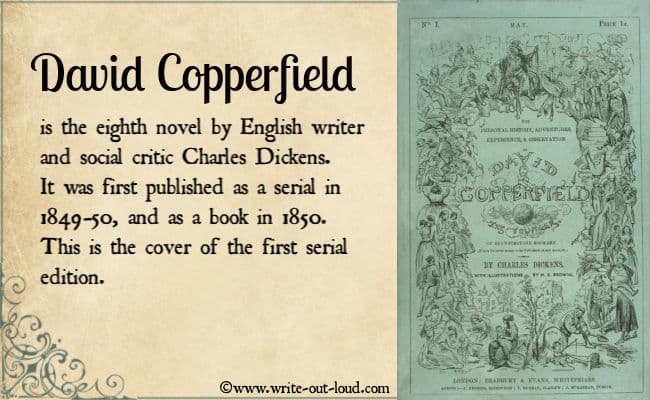
'Whether I shall turn out to be the hero of my own life, or whether that station will be held by anybody else, these pages must show. To begin my life with the beginning of my life, I record that I was born (as I have been informed and believe) on a Friday, at twelve o'clock at night. It was remarked that the clock began to strike, and I began to cry, simultaneously.
In consideration of the day and hour of my birth, it was declared by the nurse, and by some sage women in the neighborhood who had taken a lively interest in me several months before there was any possibility of our becoming personally acquainted, first, that I was destined to be unlucky in life; and secondly, that I was privileged to see ghosts and spirits; both these gifts inevitably attaching, as they believed, to all unlucky infants of either gender, born towards the small hours on a Friday night.'
Listen to a demonstration of the counting technique
The first clip is with the counting.
The second clip is without. The voice you'll hear is mine: Susan Dugdale's. I'm from New Zealand. That explains the accent!
And another practice piece:
This time it's poetry; one of Shakespeare's Sonnets:
'Shall I compare thee to a Summer's day?'
Imagine as you read it through you're talking to the love of your life. Although the poem may not use words you would choose, it expresses the power and depth of emotion associated with a very, very special person.
Use the counting method to help you at first.
Say it through several times to get the flow of ideas sorted and then play with variations.
The central theme is that his lover is more beautiful than a Summer's day.
Even though Summer is a delight, it has strong winds that blow blossoms around, it ends too soon, and the sun is sometimes too hot or clouded over.
Shakespeare goes on to say that although everything beautiful (fair) ages either, as a result of an accident (chance) or because of its nature, the love he bears will be eternal.
In his mind she will always have the qualities he cherishes, even when she is older and 'lines to time thou growest'. As long as he lives he will continue to see her this way and in doing so, will give her life. She will never die or diminish while he is there as her witness.
Shall I compare thee to a Summer's day?
Shall I compare thee to a Summer's day?
Thou art more lovely and more temperate;
Rough winds do shake the darling buds of May,
And Summer's lease hath all too short a date;
Sometime too hot the eye of heaven shines,
And often is his gold complexion dimm'd;
And every fair from fair declines,
By chance or nature's changing course untrimm'd;
But thy eternal Summer will not fade
Nor lose possession of that fair thou owest;
Nor shall Death brag thou wanderest in his shade,
When in eternal lines to time thou growest;
So long as men can breathe, or eyes can see,
So long lives this, and this gives life to thee.
Listen to 'Shall I compare thee to a Summer's day?'
I've recorded this poem without the counting. I hope my pauses make it easier for you to follow.
Practice on a range of ordinary material
Read recipes or instruction sheets aloud making sure you give time for the audience to understand the sequence of actions needed to complete the tasks. Try informative articles on subjects you're interested in. Or humor.
Practice, practice, practice & then do it some more
That's it from me. Now it's over to you to practice.
Silence is a gift you give to yourself and your audience. Used effectively it can speak louder than your words.
How?
Because in stillness spoken words reach their full potential. When you speak, you seed a thought or an image. In the pause it grows.
- Return to top of quick and easy tips for using pauses

